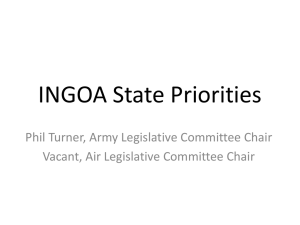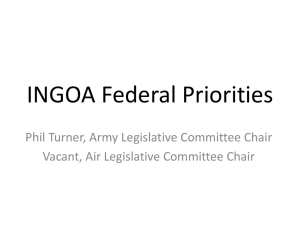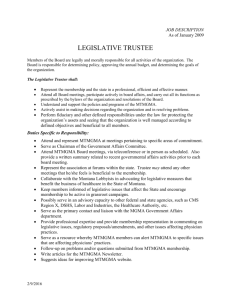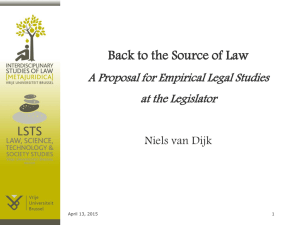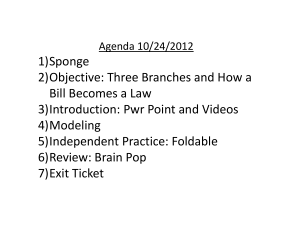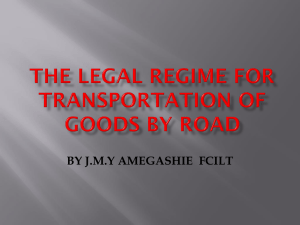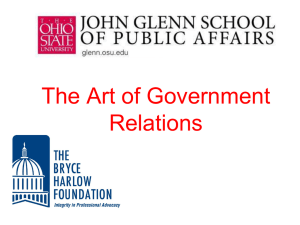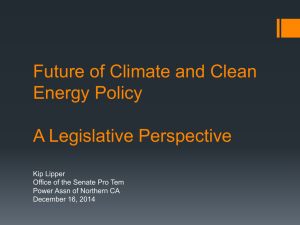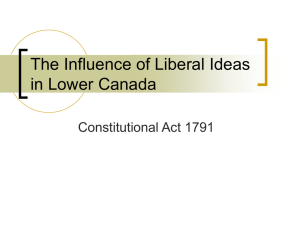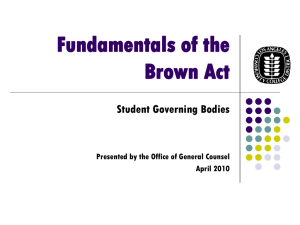Chapter 1: Introduction and history
advertisement
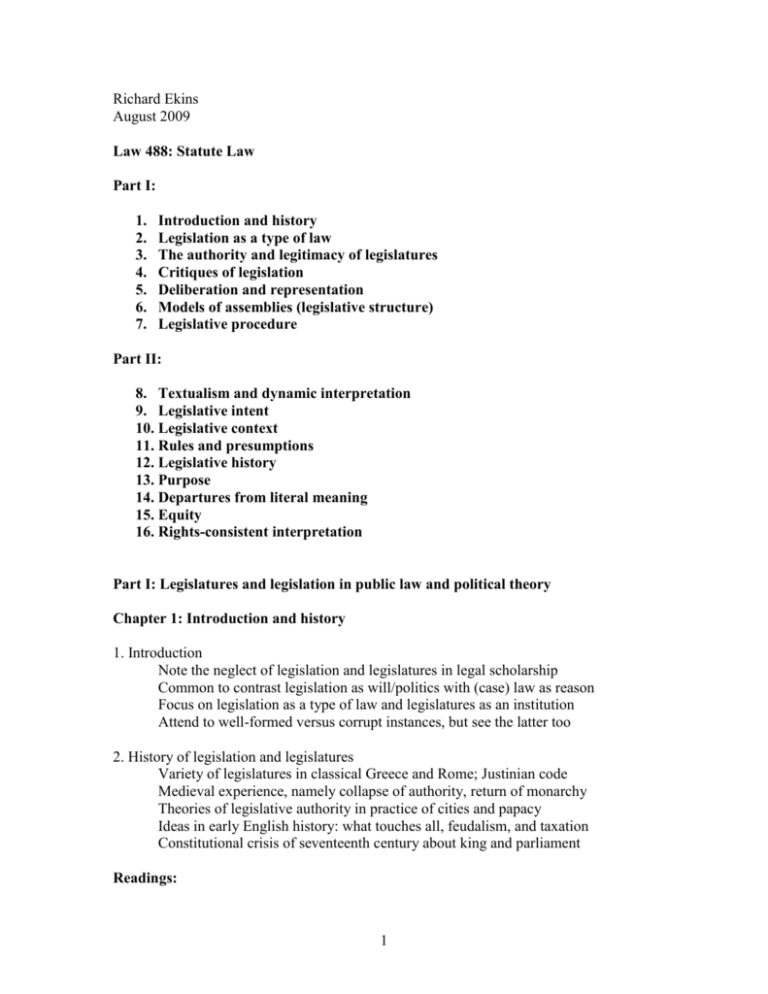
Richard Ekins August 2009 Law 488: Statute Law Part I: 1. 2. 3. 4. 5. 6. 7. Introduction and history Legislation as a type of law The authority and legitimacy of legislatures Critiques of legislation Deliberation and representation Models of assemblies (legislative structure) Legislative procedure Part II: 8. Textualism and dynamic interpretation 9. Legislative intent 10. Legislative context 11. Rules and presumptions 12. Legislative history 13. Purpose 14. Departures from literal meaning 15. Equity 16. Rights-consistent interpretation Part I: Legislatures and legislation in public law and political theory Chapter 1: Introduction and history 1. Introduction Note the neglect of legislation and legislatures in legal scholarship Common to contrast legislation as will/politics with (case) law as reason Focus on legislation as a type of law and legislatures as an institution Attend to well-formed versus corrupt instances, but see the latter too 2. History of legislation and legislatures Variety of legislatures in classical Greece and Rome; Justinian code Medieval experience, namely collapse of authority, return of monarchy Theories of legislative authority in practice of cities and papacy Ideas in early English history: what touches all, feudalism, and taxation Constitutional crisis of seventeenth century about king and parliament Readings: 1 R Van Caenegem, “Government, law and society [750–1150]”, chapter 9 in J H Burns (ed), The Cambridge History of Medieval Political Thought c. 350–c. 1450 (CUP, Cambridge, 1988) 174, 180-5, 192-5 K Pennington, “Law, legislative authority and theories of government. 1150-1300”, chapter 15.I in J H Burns (ed), The Cambridge History of Medieval Political Thought c. 350–c. 1450 (CUP, Cambridge, 1988) 424-36 J H Baker, An Introduction to English Legal History (4th edn, Butterworths, London, 2002) 204-12 J Goldsworthy, The Sovereignty of Parliament (Clarendon Press, Oxford, 1999) 229-35 Chapter 2: Legislation as a type of law 3. Types of law The nature of custom (convergence plus reason) and its limits The nature of case law (indirectly made, analogy) and its limits Merits of incremental change and the case for codification The nature of law itself: reasonably taking past acts to settle how we act now 4. The nature of legislation Deliberately made, posited, chosen by a legislature with plenary authority Public, canonical text (changing emphasis over time), formally interpreted Capable of change when need be and in principle responsive to any reasons Lawmaking in a form fit for the rule of law Waldron’s argument that legislation by assembly is analogous to custom Readings: J Burrows, “Common Law among the Statutes: The Lord Cooke Lecture 2007” (2008) 39 VUWLR, 401, 411-418 J Gardner “Some Types of Law” in D Edlin (ed), Common Law Theory (CUP, Cambridge 2007) 51, 52-7, 60-72 J Waldron, “Legislation by Assembly”, chapter 11 in T Campbell and J Goldsworthy (eds), Judicial Power, Democracy and Legal Positivism (Ashgate, Aldershot 2000) 251, 256-64 G Postema, “Philosophy of the Common Law, chapter 15 in J Coleman and S Shapiro (eds) The Oxford Handbook of Jurisprudence and Philosophy of Law (OUP, Oxford 2002) 588-9 2 Chapter 3: The authority and legitimacy of legislatures 5. Early modern theories of legislation Hobbes: consent theory, sovereignty for peace, preference for monarchy Locke: consent too, citizens retain rights, assembly avoids tyranny (rule of law) Rousseau: general will, assembly of all, avoid partisanship, imaginary lawmaker 6. The objects of legislative action: aggregate preferences Arguably, the legislature’s task is to aggregate preferences (utilitarian antecedent) Rights and judicial review often respond to this conception of the legislature Problems of preference aggregation as an object: cycling, strategic action, reasons 7. The objects of legislative action: the common good Consent is insufficient to ground legitimate authority and unnecessary The common good and justice as the reason for authority Value of public order, rule of law grounds moral obligation to maintain law What this entails: legislators should appeal to good reasons, citizens obey Readings: T Hobbes, Leviathan, A Martinich (ed) (Broadview Press, Peterborough 2005) 125-49 J Locke, Two Treatises on Government, P Laslett (ed) (CUP, Cambridge 1988), II [Second Treatise], sections 22, 94, 131-2, 134-43, 149-51 J Rousseau, The Social Contract, C Frankel (tr) (Hafner Publishing, New York 1947) 149, 23-30, 84-9 R Dworkin, ‘Social Sciences and Constitutional Rights – the Consequences of Uncertainty’ (1977) 6 Journal of Law and Education 3, 10 R Dworkin, Sovereign Virtue: The Theory and Practice of Equality (Harvard University Press, Cambridge Mass 2000) 204-5 R Dworkin, Freedom’s Law: the Moral Reading of the American Constitution (Harvard University Press, Cambridge, Mass 1996) 344-5 J Finnis, Aquinas: Moral, Political, and Legal Theory (OUP Oxford 1998) 222-8, 255-66 B Miller, ‘Justification and Rights Limitation’ in G Huscroft (ed), Expounding the Constitution (CUP, Cambridge 2008) 93, 101-5 P Yowell, “A critical examination of Dworkin’s theory of rights” (2007) 52 American Journal of Jurisprudence 93, 130-7 3 Chapter 4: Critiques of legislation 8. An inferior source of law Paradox of Weber and rational lawmaking vs. economic success of England Superiority of spontaneous order over rational lawmaking (Hayek) The argument for judicial recognition that statutes have lapsed (Calabresi) 9. Public choice Assumptions (self-interest, rationality) and antecedents (game theory etc.) Conception of legislators (re-election) and legislating (market for lobbyists) Problems: responds to American politics, cynical/passive account of legislators Readings: F Hayek, Law, Legislation and Liberty: Rules and Order (University of Chicago Press, Chicago 1973) 72-73, 122-131 G Calabresi, A Common Law for the Age of Statutes, (HUP, Cambridge, Mass. 1982), “Choking on Statutes” 1-7 W Eskridge, “Politics Without Romance: Implications of Public Choice Theory for Statutory Interpretation” (1988) 74 Virginia Law Review 275, 280-95 K Shepsle, “Congress is a ‘They,’ Not an ‘It’ Legislative Intent as Oxymoron” (1992) 12 International Review of Law and Economics 239, 240-1 Chapter 5: Deliberation and representation 10. The nature of the legislative assembly Note the oddness in one way of having a large assembly at all The reasons for size – capacity to represent – and for assemblies – avoid tyranny Persistent worries about size of legislature and good decisionmaking Is the assembly a second-best alternative to direct democracy and referenda? 11. Representation Authorisation and accountability, descriptive and symbolic representation Trustee versus delegate; connection to the purpose of legislation How independent should legislators be from their constituents’ preferences? Political parties as obstacles to or supporters of representation The arguments for representative democracy over direct democracy 12. Deliberation What it is to deliberate, and what it legislators deliberate about How deliberation occurs, where and by whom it is conducted 4 The extent to which bills change across the legislative process Obstacles to deliberation (partisanship, parties, civil discourse, publicity) Readings: J Waldron, “Representative Lawmaking” (2009) 89 Boston University Law Review 335355 G Brennan and A Hamlin, Democratic Devices and Desires (CUP, Cambridge 2000) 156-9, 185-91 R Hardin, “Representing Ignorance” (2004) 21 Social Philosophy and Policy 76-91 E Burke, ‘Speech to the Electors of Bristol’ [1774] in R Hoffmann and P Levack (eds), Burke’s Politics, Selected Writings and Speeches (A A Knopf, New York 1949) 115 Chapter 6: Models of assemblies (legislative structure) 13. Washington vs. Westminster Two models of separation of powers; how does executive stand to legislature Washington executive is a rival, Westminster it is an agent Advantages of each: unified executive, checks/balances; responsible government Pathologies of each: gridlock, authoritarian regression; elective dictatorship 14. Models of legislatures Transformative and arena; engine of policy development or place for discussion Variations noted by Polsby (Westminster as policy-influencing) Basic failure of the models; executive is part of legislature; parliamentary politics Hansard Society report on legislative process as transformations 15. Bicameralism Varieties of upper house: appointed, elected, equal or subordinate Merits: extended deliberation, more checks, less partisan, different selection Problems: cost, how to select, lower house relations, legitimacy, NZ experience Readings: J Carey, ‘Presidential versus Parliamentary Government’, chapter 5 in C Ménard and M Shirley (eds), Handbook of New Institutional Economics (Springer, Amsterdam 2005) 91-95 N Polsby, ‘Legislatures’, chapter 7 in P Norton (ed), Legislatures (OUP, Oxford 1990) 129-131, 141-2 (plus P Norton’s ‘Introduction’ to this section at 127-8) M Mezey, ‘Classifying Legislatures’, chapter 8 in P Norton (ed), Legislatures (OUP, 5 Oxford 1990) 149, 151-6 J Uhr, “Bicameralism”, chapter 24 in R. A. W. Rhodes, Sarah A. Binder, Bert A. Rockman (eds.) The Oxford Handbook of Political Institutions (OUP, Oxford 2006) 47494 Chapter 7: Legislative procedure 16. Legislative state of nature and procedures Cox on the legislative state of nature and difficulty of action The universal answer is internal hierarchy, which means agenda control & rules Varieties of agenda power (positive, negative; earlier, later; centralised or not) Legislative officers, parties, committees; outline of Congress and its veto-gates The significance of agenda power given cycling and majoritarianism 17. New Zealand’s legislative process The detail of our legislative process; salient legislative rules (committees, etc.) Rules about urgency, quorum, etc.; their rationale, use and abuse Causes of the abuses (size of legislature, MMP in part, media, culture) How to answer the problems: better rules, bicameral, more MPs, cultural change Readings: G Cox, ‘The Organization of Democratic Legislatures’, chapter 8 in B Weingast and D Wittman (eds) The Oxford Handbook of Political Economy (OUP, Oxford 2006) 141-61 J Burrows and R Carter, Statute Law in New Zealand (4th edn, LexisNexis, Wellington 2008) 71-86 J Waldron, Parliamentary Recklessness: Why we need to legislate more carefully (John Graham Lecture, Maxim Institute, Auckland 2008) 20-33 Part II: Statutory interpretation Chapter 8: Textualism and dynamic interpretation 1. New textualism Classical intentionalism; doubts about intention Hart & Sachs legal process school, reasonable purposes Literal approach in 19th century and revival in America The appeal and content of new textualism Problems with the approach, namely mismatch with practice 2. Dynamic interpretation 6 Heir to the pragmatist tradition; advance critiques of all approaches Take everything into account and make best decision Interpretive funnel; post-enactment changes, describing practice Appeal (updating, accurate) but problems (incoherent, arbitrary) Readings: E Garrett, “Legislation and Statutory Interpretation”, chapter 20 in K Whittington, R Kelemen, and G Caldeira (eds), The Oxford Handbook of Law and Politics (OUP, Oxford 2008) 360-72 M Sinclair, “Legislative Intent: Fact or Fabrication?” [Book Review Essay of Dynamic Statutory Interpretation, by W Eskridge] (1997) 41 New York Law School Law Review 1329, 1365-86 Chapter 9: Legislative intent 3. Semantics and pragmatics The code theory of language and its failure The difference between semantics and pragmatics What sentences mean and what speakers mean The underdetermination thesis; how hearers understand speakers Context and meaning in any particular utterance 4. Arguments against legislative intent Radin’s early argument that there is no single lawmaker Dworkin’s famous critique: the arbitrariness of aggregation Waldron on the structure of the democratic assembly Shepsle on social choice theory and majority cycling, agenda control 5. Standard attempts to explain legislative intent Marmor et al on shared majority intention: summative failing Solan et al on delegated intention: failure to explain how legislators reason McNollgast and positive political theory: private bargains are not law 6. A new account of legislative intent Particular and standing group intentions, aspiration to rational unity Legislating well requires coherent, unified action: intend X for Y reasons The legislative process is set up to enable reasoned open proposals What the legislators do is jointly to enact proposals put before them Detail of legislative process supports this; rational legislators think this Intentions of particular legislators are irrelevant; minority participates Readings: 7 S Neale, “Pragmatism and Binding”, chapter 5 in Z Szabó (ed), Semantics vs. Pragmatics (OUP, Oxford 2005) 165, 176-96 J Raz, “Intention in Interpretation” in R George (ed), The Autonomy of Law: Essays on Legal Positivism (OUP, Oxford 1996) 249, 258-9, 265-71 R Ekins, “The relevance of the rule of recognition” (2006) 31 Australian Journal of Legal Philosophy 95, 102-17 Chapter 10: Legislative context 7. The semantics of statutes and legislative context Legislators have good reason to be clear but not always literal Imprecision in drafting is possible & brevity and clarity are vital Marmor argues legislative context is thin; Manning says two kinds Context is rich, including previous law, mischief, words and history Readings: F Bennion, Bennion on Statutory Interpretation (5th edn, LexisNexis, London 2008) 5889 (s.202), 1155-67 (s.355) A Marmor, “The Pragmatics of Legal Language” (2008) 21 Ratio Juris 423, 429, 434-5 J Manning, “What Divides Textualists From Purposivists” (2006) 106 Columbia Law Review 70, 92-5 Chapter 11: Rules and presumptions 8. Canons, maxims and qualifying rules An outline of the various kinds of rules and their status Rules of linguistics (Gricean maxims, etc.) Rules of policy (presumptions as a certain kind, qualifying rules) 9. Presumptions [Defer human rights until later, but note ‘legality’ principle] Lenity Common law preservation Tax Readings: Interpretation Act 1999, ss 5-7 and its predecessor Acts Interpretation Act 1924 (repealed), s 5 8 J Evans, Statutory Interpretation: Problems of Communication (OUP, Auckland 1988) 293-305 J Evans, “Questioning the Dogmas of Realism” in R Bigwood (ed) Legal Method in New Zealand (Butterworths, Wellington 2001) 283, 293-5 R Cross, Statutory Interpretation (3rd edn, by J Bell and G Engle, LexisNexis, London 1995) 170-83 Sellers v Maritime Safety Inspector [1999] 2 NZLR 44, 48, 57-62 Chapter 12: Legislative history 10. Legislative history: pre-enactment, Hansard The previous state of the law (Heydon’s case) The traditional rule re Hansard Pepper v Hart and NZ’s change (contrast US, Australia) Problems with the new situation The new critique (Scalia et al) 11. Legislative history: Hansard, post-enactment (inaction) How to use legislative history Theories about how history relates to action (positive political) The (in)significance of legislative inaction Readings: J Burrows and R Carter, Statute Law in New Zealand (4th edn, LexisNexis, Wellington 2008) 258-73 J Evans, “Controlling the Use of Parliamentary History” (1998) NZULR 1, 25-45 Chapter 13: Purpose 12. Purpose The new significance of purpose (Interpretation Act, etc.) Obvious relevance and connection to intention How to discern the purpose(s) and what use to make of it or them Abuse of purpose (ignoring decisions, etc.) Readings: 9 J Burrows and R Carter, Statute Law in New Zealand (4th edn, LexisNexis, Wellington 2008) 208-29 Frucor Beverages Ltd v Rio Beverages Ltd [2001] 2 NZLR 604-615 Chapter 14: Departures from literal meaning 13. Ambiguity (and vagueness) Types of ambiguity: word, syntactic, pragmatic Ambiguity distinguished from vagueness How to resolve either type of doubt 14. Non-literal meaning (and ellipsis and limited domain) Instances where a non-literal meaning is meant Ellipsis in statutory drafting and its recognition Limited domain as an alternative but related phenomenon 15. Implications and the status of rules Implications in statutes; what is commonly implied Implied repeal, limits on powers, qualifying rules The status of rules, directory or mandatory Readings: J Evans, Statutory Interpretation: Problems of Communication (OUP, Auckland 1988) 72-5, 80-3, 85-94, 104-5, 107-16 J Evans, “Reading Down Statutes” in R Bigwood (ed), The Statute: Making and Meaning (LexisNexis, Wellington 2004) 123, 126-30, 148-9 F Bennion, Bennion on Statutory Interpretation (5th edn, LexisNexis, London 2008) 491501 (ss.173-5) [on implications] Chapter 15: Equity 16. Equity: exceptions The distinction between practical choice (judgment) and meaning Cases where the two come apart and the hard choice to make Authority is consistent with either, but especially with choice Two types: reasons not present and reasons outweighed How to limit exceptions to cases that respect legislative authority 17. Equity: extensions Related phenomenon where meaning does not capture choice 10 How to extend the statute to capture choice Dangers of so doing and difficulty in judging extension Relation to but difference from reasoning by analogy to the statute Readings: J Evans, “A Brief History of Equitable Interpretation in the Common Law Systems” in J Goldsworthy and T Campbell (eds), Legal Interpretation in Democratic States (Ashgate, Aldershot 2002) 67-92 Chapter 16: Rights-consistent interpretation 18. Rights-consistent interpretation The interpretive obligations in HRA and NZBORA Two bad readings of that obligation: entrenchment, semantic opportunism Limitation of general terms and strengthening of presumption Range of cases that depart from this position and run into trouble Readings: R v A (No 2) [2001] 2 WLR 1546, 1555-6, 1559-64 R Ekins, “A Critique of Radical Approaches to Rights Consistent Statutory Interpretation” (2003) EHRLR 641-50 J van Zyl Smit, “The New Purposive Interpretation of Statutes: HRA Section 3 after Ghaidan v Godin-Mendoza” (2007) 70 MLR 294-306 11
